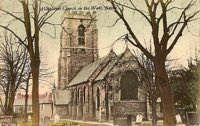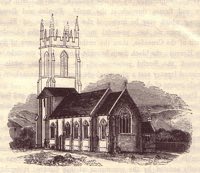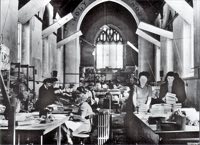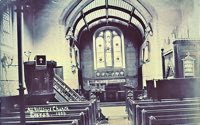
All-Hallows-on-the-Wall, Bartholomew Yard
Page updated 5th November 2017
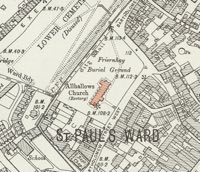 One of the lost churches of
Exeter, All-Hallows-on-the-Wall, Bartholomew Yard was designed to
replace the original All-Hallows-on-the-Wall which was situated at the
bottom end of Fore Street. The old church had been badly damaged during the
siege of Exeter by the defending Royalists, during the Civil War, become roofless and derelict over the next years. The three bells were removed in 1657 and sold for
£30. It was demolished in May 1770 after works were commenced
to build New Bridge Street, leaving the parish without a church, but leaving the parish intact.
One of the lost churches of
Exeter, All-Hallows-on-the-Wall, Bartholomew Yard was designed to
replace the original All-Hallows-on-the-Wall which was situated at the
bottom end of Fore Street. The old church had been badly damaged during the
siege of Exeter by the defending Royalists, during the Civil War, become roofless and derelict over the next years. The three bells were removed in 1657 and sold for
£30. It was demolished in May 1770 after works were commenced
to build New Bridge Street, leaving the parish without a church, but leaving the parish intact.
Bartholomew's Churchyard was taken out of commission when the Lower Cemetery and Catacombs were opened in August 1837. The decision to clear the churchyard and build a new church was made, and in 1843 John Hayward was chosen as architect. Built in the perpendicular style, it consisted of a chancel, nave, south porch and a tower with pinnacles, containing a single bell. The foundation stone was laid on 4 April 1843 by Bishop Phillpotts.
The new church, which cost £3,500, and could accommodate 150 sittings, was consecrated in September 1845. Constructed of limestone, with Beer stone dressings; the tower was added in 1849. The south window of the chancel had stained glass added in memory of Mr and Mrs Cornish, while the east window had four stained glass panels with evangelists as subjects. The church's communion plate was presented by Canon Rogers, and the altar-cloth was the gift of the Mrs. Ford. The parish registers for both All Hallows go back as far as 1694.
The church received virtually no attention from the Flying Post during the nineteenth-century apart from reporting, in April 1897, the parishioners presenting the Rev. J Sparshatt, the curate for the previous fifteen years a scroll and purse of gold, on his appointment to St Olaves in the High Street. By 1902, the Beerstone pinnacles on the tower were badly worn, and removed.
The parishes of St Olaves and All Hallows were combined under the Rev E C Long in 1939. With declining attendances, and the outbreak of war, the church was closed to become a parachute factory. After the war they produced corsets before it was closed and demolished in 1951. Now, Bartholomew Yard is a pleasant, tree filled park with a few scattered gravestones sunk in the grass. There are two remaining graves in the corner of the yard, one of which gained some importance when the City Council applied to widen Barthomomew Street for an inner-bypass. They had to obtain the permission of any living relatives of family graves that would be moved for the works. Living relatives, in the United States of the one remaining grave refused permission, and the bypass scheme was abandoned, much to the relief of the locals in the houses on the opposite side of the road.
Sources: White's 1850, Kelly's 1897 and the Flying Post. Exeter Churches by Beatrix Cresswell.
│ Top of Page │

